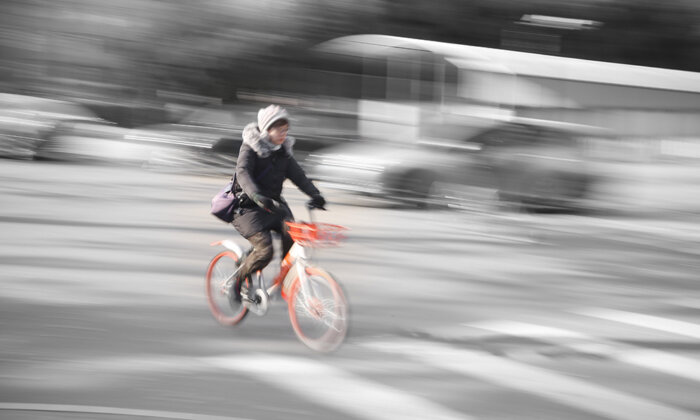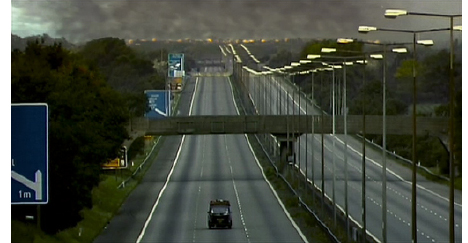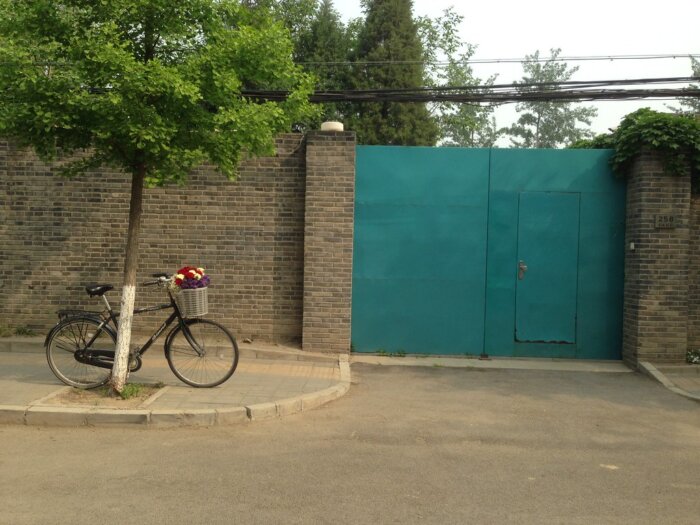What State Is the Art of Cycling of Arts in
Cycling, Art, and Utopian Possibilities
Confronting the grim groundwork of the Covid-19 catastrophe, in that location is some small cause for hope in the current renewal of enthusiasm for cycling.

In the class of researching my latest book on the screen history of the wheel, I watched hundreds of films featuring cycling and cyclists. One of the things that struck me again and once again about the films I viewed was how enviably empty the roads are.
According to a recent road traffic estimate released by the U.Thousand. authorities'southward Department for Transport, motor traffic in the U.K. has increased past more than than 10 times since 1949, well-nigh of this driven past private automobile use. And so the experience of negotiating British roads whether as a driver or passenger, cyclist or pedestrian, is all likewise often frustrating and terrifying. Equally someone who regularly rides a wheel, the open roads in some of the films I was analyzing looked about utopian, equally if the films were documents from an irretrievable past.
Of course, as in other countries, one of the consequences of the U.Grand.'south fractional lockdown in response to the Covid-19 pandemic is that we have seen the roads suddenly emptied of motor traffic nearly overnight, while the skies overhead take become nearly free of the contrails of jet aircraft, the clatter of helicopters, and the acrid brume of exhaust fumes.
The news media accept been documenting the spectacular evacuation of these public spaces, paying item attention to the uncanny emptiness of urban spaces that would normally be thronging with crowds. The similarity betwixt photographs of deserted metropolis centers and the opening shots of eco-horror picture show fantasies such as "The Mean solar day the Earth Defenseless Fire," "Dawn of the Dead," "28 Days Later," or "I Am Legend" is irresistible. For filmmakers, the prototype of an empty route is a powerful device for visualizing radical and catastrophic social change.
For filmmakers, the image of an empty route is a powerful device for visualizing radical and catastrophic social alter.
Even so, one of the surprising features of the lockdown has been that, in gild both to let key workers remain mobile and to encourage people to remain physically agile, a number of cities around the world have been making renewed efforts to encourage cycling by closing roads to motor traffic, and widening and extending wheel lanes and footpaths. Every bit in most aspects of its response to the pandemic, the U.K. government has lagged backside other countries in this area, simply in mid-Apr the Section for Transport announced that local authorities would be permitted to close roads in club to facilitate essential mobility (while promising at the same fourth dimension that these looser rules will be "withdrawn once conditions allow").

And just as we are seeing an unprecedented effort to facilitate the movements of cyclists and pedestrians by city councils and local authorities, it seems that in that location has been a corresponding boom in the demand for bicycles, with a director of one wheel shop in Sydney, Australia declaring, "We're the new toilet paper and everyone wants a piece." In the context of a global catastrophe that even so appears to be in its early on stages, what is tentatively hopeful virtually this phenomenon is that it could exist the ground for a new more sustainable infrastructure when we emerge from the pandemic, laying the foundation for a dissimilar conception of mobility. For example, Leicester Metropolis Council, in the U.M., which is exploring 'tactical urbanism' in its approach to boondocks-planning, has announced that it is considering installing a new network of bike lanes to "enable those who take used the temporary lanes to keep cycling or walking once the lockdown ends."
It is appropriate that the bicycle is one of the objects through which differently mobile futures are existence apposite and imagined. Bicycles are everyday objects for most of u.s.a.: applied tools for traveling to and from work or the shops, equally well equally devices that we use for exercise or for fun. Even so, they are also semiotically flexible vehicles for a range of associated meanings, and then function equally expressive devices. The type of bike nosotros ride, the mode we ride it and the clothing we clothing comprises a rich assemblage of signs about grade, gender, race, nationhood, and politics equally well as individual personality.
The type of bike we ride, the fashion we ride information technology and the clothing we wear comprises a rich assemblage of signs well-nigh class, gender, race, nationhood, and politics too as individual personality.
Ai Weiwei, the exiled Chinese artist at present living in the U.K., has made all-encompassing utilise of bikes in his art and observes, "The bicycle is very symbolic in China considering it'south just similar grass really, it belongs to ordinary life and the way we grow upward, and still a bicycle is also a luxury and practical." Whereas the bicycle was once closely associated with People's republic of china's social and economical organization due to Chinese leader Deng Xiaoping's promise to put a 'Flying Pigeon' brand bicycle in every home, now, in China equally elsewhere, car ownership has become a powerful symbol of abundance and social progress. As a consequence, those who ride bikes are increasingly either members of the affluent centre classes or those people besides poor to afford a auto or motorbike; among other things, this shift is an indication of the style that the symbolic significance of the wheel is in perpetual motion.
Ai has produced an ongoing series of spectacular, intricate sculptural works assembled from dozens, hundreds, or sometimes thousands of identical bikes, which invite us to read them as commentaries on wasteful industrial over-product among other possible interpretations. Moreover, given that they are made from and named after 'Forever' bikes, the most ubiquitous Chinese make, we might also sympathize these works as an ironic commentary upon the Chinese government'due south expansive ideological project.

On a smaller scale, i of Ai'due south most moving bicycle works, "With Flowers," draws out another symbolic dimension of the bicycle. Combining digital photography with public sculpture and performance fine art, "With Flowers" was produced afterwards the Chinese regime confiscated his passport in 2011, banning him from traveling outside China. In protest at the injustice of this lockdown, Ai placed his cycle in the street outside his studio gates in Beijing and every twenty-four hour period for nearly 2 years, he placed a bouquet of flowers in the handbasket, and posted a photograph of the flowers online. In a very simple style, the association of the bicycle with complimentary movement takes on a renewed political significance in this piece of work which as well represents a quietly defiant insistence upon beauty in the face of political repression. More pointedly, "With Flowers" invokes indirectly the Hundred Flowers Campaign in which, for a cursory period in the 1950s, Mao Zedong solicited criticism of the Communist regime with the literary quotation, "Let a hundred flowers blossom; permit a hundred schools of thought contend."
The bicycles that recur throughout Ai'southward work tin can also exist understood as making a more specific reference to the injustices of the Chinese state, serving equally memorials to Yang Jia, a Beijing resident who was arrested in 2007 for riding an unlicensed bicycle and who was the field of study of "One Recluse," a 2010 documentary past Ai. Having made allegations of law brutality after his abort, Yang was later on executed in 2008 after he attacked a police station in revenge, killing half dozen law officers and wounding another. With the trial held behind closed doors, Yang's case became a cause célèbre since, for some commentators, his activeness was seen every bit a course of protestation against an oppressive authorities.
Thus, for Ai, as for the suffragists of the tardily xixth and early 20th century, the bicycle is deployed in his work as a tool with which to protest against inequality and express a demand for a new social order. From the late 19th century onwards, the attraction of cycling for many of its advocates was that the greater physical mobility offered by bicycles and tricycles would engender greater social mobility. Most notably, perchance, it offered women a degree of personal mobility that was previously only available to men. This sense of exhilarating possibility is captured in "Hyde Park Bicycling Scene," the delightful 1896 actuality by early filmmaker Robert W Paul, which shows women happily wheeling past horse-drawn carriages and male cyclists.
Hyde Park Bicycling Scene (1896)
For its advocates, the cycle promised to ship its passenger to a more equal future, but for various reasons, we have yet to make it there. Women remain less likely to cycle than men, while, as the transportation equity advocate Melody Lynn Hoffmann has observed, "Mainstream bicycle culture and advocacy in the United states is dominated by heart- to upper-class white bicyclists." Notwithstanding, confronting the grim background of the electric current global catastrophe, in that location is some minor cause for hope in the current renewal of enthusiasm for cycling. The lockdown imposed in various countries around the world in order to command the spread of the virus has become a grand, accidental experiment with living in a non-car-dependent world. Information technology poses the challenge of how to cover what Greater Manchester's mayor Andy Burnham terms "a new normality" that encompasses a "national re-evaluation of work," sustainable energy policy, improved internet connections and amend walking and cycling networks.
Just every bit the Covid-19 crisis has revealed in the starkest terms the inadequacy of laissez-faire capitalism, nationalist exceptionalism and libertarian ideology when faced with a large-calibration crisis, information technology has likewise revealed the possibility that the pandemic need not be followed by a render to business concern as usual.
Reports take indicated that a key reason the U.Yard. government was reluctant to introduce lockdown measures in response to the spread of Covid-xix was that (alongside an ideological commitment to protecting the economic system above all else, and an ill-conceived strategy of 'herd immunity' advocated past the country's chief scientific adviser) they believed that the population would not comply with what the prime minister described as draconian measures. What the collective public response has demonstrated however, is that people will willingly change their beliefs radically, en masse, and almost overnight, if persuaded that it is socially necessary. This is cause for hope not simply in relation to the current pandemic merely also in relation to the catastrophic threat posed by global heating which, it seemed until just a few months ago, was unstoppable due to people's intransigence and self-interest.
Just as the Covid-nineteen crunch has revealed in the starkest terms the inadequacy of laissez-faire capitalism, nationalist exceptionalism and libertarian credo when faced with a large-scale crisis, it has likewise revealed the possibility that the pandemic need not be followed past a return to business every bit usual. At a moment in which information technology seems that the dystopian futures imagined by science-fiction films and speculative literature could be realized, the proliferation of bicycles on the quiet, empty roads around the states presents us with an near utopian counter-image of a different, slower, calmer social lodge that is well inside our reach.
In his history of cycling, "King of the Road," published in the aftermath of the 1973 oil crisis, Andrew Ritchie observed that this mundane, over-familiar motorcar, that was by then over 150 years' old, retained its power to transform the world: "We take the cycle too much for granted, but at the same time, nosotros in England do not use it enough. It is a simple machine. Simply it could have a far-reaching and revolutionary effect on the world in the adjacent century." Mayhap it is time for a revolution.
Bruce Bennett is Senior Lecturer and Director of Movie Studies at Lancaster University. He is the author of "Cycling and Movie theatre."
Source: https://thereader.mitpress.mit.edu/cycling-art-utopian-possibilities/
0 Response to "What State Is the Art of Cycling of Arts in"
Post a Comment